Upper Respiratory Infection Versus Lower: What’s the Difference?

The body's respiratory system includes the nose, sinuses, mouth, throat (pharynx), voice box (larynx), windpipe (trachea), and lungs. Upper respiratory infections affect the parts of the respiratory tract that are higher on the body, including the nose, sinuses, and throat, while lower respiratory infections affect the airways and lungs.
Upper Respiratory Infection
Types of upper respiratory infection include the common cold (head cold), the mild flu, tonsillitis, laryngitis, and sinus infection. Of the upper respiratory infection symptoms, the most common is a cough. Lung infections may also lead to a stuffy or runny nose, sore throat, sneezing, achy muscles, and headache.
Lower Respiratory Infection
Lower respiratory infections may be found in your lungs or breathing airways. They can be caused by viral infections like the severe flu or bacterial infections like tuberculosis. Lower respiratory infection symptoms include a severe cough that may produce mucus (phlegm), cause shortness of breath, chest tightness, and wheezing when exhaling.
Whooping Cough (Pertussis)

Whooping cough (pertussis) is caused by the Bordetella pertussis bacterium. Uncontrollable, violent coughing that can make it difficult to breathe is characteristic of this lung infection. The whooping sound comes from an ill person sucking in air after a coughing fit. Anyone, including adults, can get pertussis, but infants stand a particularly severe, even life-threatening, risk.
The pertussis vaccine is recommended for both adults and children. This vaccine helps prevent the spread of infection of whooping cough in infants and others. Vaccines are available beginning at 2 months old, and typically require four more doses at regular intervals with the last dose given at age 4-6.
Swine Flu (H1N1)

Swine flu (H1N1) is a respiratory illness caused by the Influenza-A virus. A virus's genetics allow that particular virus to live inside a specific species, like a human, cat, dog, monkey, and others. The swine flu gets its name because the viruses that causes swine flu (H1N1v viruses) show genetic similarities to viruses that infect pigs.
As with any seasonal flu, swine flu can cause fever, throat pain, a general feeling of being unwell (malaise), headache, chills, muscle pain, and joint pain. This lung infection may also cause vomiting and diarrhea.
Can You Catch Swine Flu from Eating Pork?
Swine flu cannot be spread by eating cooked pork products. It is possible for swine flu to spread from pigs to humans, though this type of spread is most common among people in places like pig barns and livestock fair exhibits housing numerous live pigs. Usually, swine flu is spread from person to person though sneezing or kissing. H1N1 flu is typically contagious from 1 to 7 days of the initial viral infection.
Swine Flu Vaccine
The swine flu vaccine is prepared either as a shot or as a nasal spray. As a shot, the swine flu vaccine is a "killed virus" vaccine. As a nasal spray, the H1N1 virus vaccine is a "live virus" vaccine that has been weakened (attenuated). In each case, the swine flu vaccine works by exposing patients to a small dose of the virus, which helps the body develop its own immunity to swine flu. People as young as six months old can begin to receive swine flu vaccination.
Bird Flu (Avian Flu H5N1)
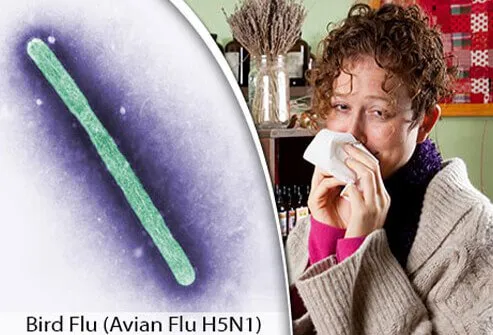
Avian (bird) flu is an illness also caused by an influenza- A virus. Most human illnesses from avian flu have been caused by the LPAI (low pathogenic avian flu) H7N9 and HPAI (high pathogenic avian flu) H5N1 variants that have genetic similarities to viruses found to infect birds. People infected with bird flu have often been in close contact with sick birds and their droppings, or in direct contact with someone else already infected with the bird flu virus.
Bird flu can cause fever, difficulty breathing, diarrhea, headache, body aches, confusion, sore throat, and runny nose. Bird flu can be life threatening. About 40% of those infected with H7N9 and 50% of people infected with the H5N1 variant die from complications.
Bird Flu Treatment
Antiviral medications are usually prescribed and can help you cope with avian flu. Severe infections usually require hospitalization in an intensive care unit with supportive treatments like mechanical breathing support and oxygen administration.
Bird Flu Vaccination and Prevention
The best way to prevent bird flu it is to avoid sources of exposure like contaminated poultry farms, aviaries, or coops. In case of a bird flu outbreak, an H5N1 vaccine is available from the US government; it is not typically suggested as a season flu vaccine.
Enterovirus
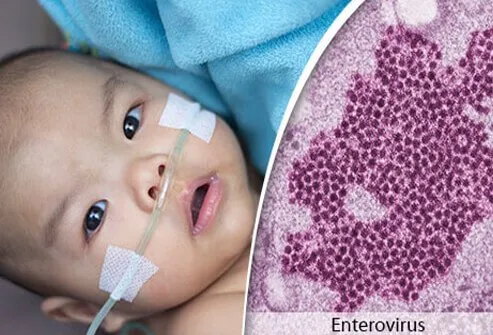
Non-polio enterovirus refers to a group of very common viruses that cause 10 to 15 million infections annually. There are many non-polio enteroviruses such as enterovirus 71, which has caused large outbreaks of hand, foot, and mouth disease worldwide, but typically most people infected by enterovirus experience nothing more than the common cold. Anyone can get the enterovirus, which is transmitted through person-to-person contact. Those most likely to exhibit enterovirus symptoms are infants, children, and teens.
Enterovirus may resemble a common cold at first, with fever, runny nose, sneezing, skin rash, mouth blisters, and body and muscle aches. Of the many types of enterovirus, about half are known to cause an enterovirus rash. People affected by enterovirus symptoms may also have trouble breathing and experience wheezing.
Enterovirus Treatment
Many infected patients can be treated by their primary care physician. If complications arise, infectious-disease specialists, critical-care specialists, cardiologists and/or lung specialists may be called on for treatment. There are currently no antiviral medications available for non-polio enteroviruses.
Flu in Children
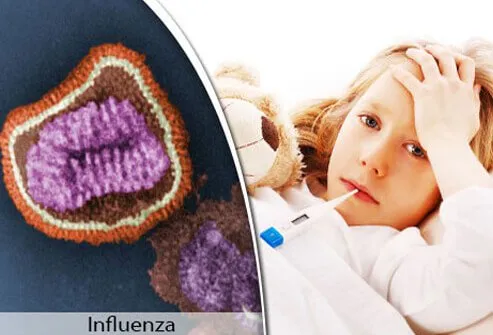
Seasonal influenza ("the flu"), is an acute respiratory illness caused by influenza A or B viruses and is most dangerous to children, seniors, and those with weakened immune systems. The flu is contagious, spreading through droplets created anytime an infected person sneezes or talks. Children may be able to pass the flu virus for longer than seven days, and some people who are infectious may show no symptoms of flu.
Flu illness begins one to four days after the virus enters your body, and can cause fever, chills, throat pain, runny or stuffy nose, muscle or body aches, headaches, and fatigue. Flu symptoms in children may also include vomiting and diarrhea.
Differences Between Flu and Stomach Flu
Although flu may cause vomiting and diarrhea, especially in children, this does not necessarily mean a child has "stomach flu." Stomach flu is caused by intestinal infection from a virus, typically rotavirus or norovirus. In other words, stomach flu is actually a different disease all together from "the flu."
Flu Complications in Children
The Centers for Disease Control (CDC) estimates about 20,000 children under the age of 5 are hospitalized due to flu complications every year. Severe complications are most common in children under 2 years old.
Flu Prevention, Including Flu Shots
Everyone 6 months of age and older should get a flu shot annually to help prevent the spread infection. Vaccines contain inactive (dead) viruses triggering an immune response without infection. This helps the body produce flu antibodies thus preventing further infection.
A nasal spray vaccine contains an attenuated live virus and has been approved for use in people ages 2-49.
The CDC recommends everyone get a flu shot as soon as they become available, or at least by October as the flu shot takes up to 2 weeks to become effective. Beyond vaccination, experts recommend keeping children home if they are sick with the flu. Washing hands often with soap and water when available, and when not, using an alcohol-based hand rub. Avoid sharing food, utensils, dishes, bedding and clothes with children who are sick with the flu. Clean and disinfect frequently touched surfaces such as toys and play areas to prevent the spread of flu viruses.
Flu in Adults

Seasonal influenza ("the flu") in adults is also caused by the Influenza A or B viruses. The flu can be unpredictable and flu symptoms can range from mild to severe. Flu symptoms in adults are often the same as in children: fever, chills, sore throat, runny or stuffy nose, muscle or body aches, headaches, and fatigue. Vomiting and diarrhea may also count among flu symptoms in adults, though this is more common in children.
Adult Flu Complications
Complications of the flu can include bacterial pneumonia, ear infection, sinus infection, dehydration, and worsening of chronic medical conditions, such as congestive heart failure, asthma, or diabetes. The Centers for Disease Control (CDC) estimates 200,000 people are hospitalized each year due to flu complications and deaths from the flu range from 3,000 annually to 49,000, depending on the severity of the flu virus in a particular season. Seniors and those with compromised immune systems are the most at risk for flu complications.
When is Flu Season?
Each year, different flu viruses spread at different times each year. In the United States, flu season begins as early as October and ends as late as May. Flu infections usually peak in January/February or later in some years.
Flu Prevention, Including Flu Shots
Getting a seasonal flu vaccine is the best way to prevent the flu. All healthy and eligible adults should get a flu shot every flu season. It takes two weeks from the time of vaccination for antibodies to develop in the body to protect against the flu. Some people are not suitable for flu shots. A person's age, health history and allergies (including egg allergy) should be considered before receiving a flu shot.
Bacterial Pneumonia

One common cause of pneumonia is bacterial infection. Bacterial pneumonia usually causes a cough that produces mucus from your lungs (sputum). Anyone can be infected, but some people stand a greater risk, including those who:
- suffer from a viral infection,
- have another respiratory disease, or
- are recovering from surgery.
Antibiotics are highly effective in treating bacterial pneumonia, so long as the bacteria are not resistant to the antibiotics. Most people see improvement within two to three days after beginning antibiotic treatment but some cases last longer, even with IV antibiotics.
Bacterial pneumonias, except for tuberculosis, are not very contagious. They can occur from bacteria normally found in your nose or throat which then spread to the lungs for a variety of reasons.
What Is Walking Pneumonia?
Though not a medical term, many people use this phrase to describe a mild form of pneumonia. One third of those who contract Mycoplasma pneumoniae (M. pneumoniae) bacteria develop this milder variation. Viruses can cause it, too. Walking pneumonia lung infections occur most often in crowded settings such as schools, military barracks, nursing homes, and hospitals.
Viral Pneumonia

Viral pneumonia is a lung infection that can occur in anyone of any age, but is more common in young children and the elderly. Common causes include Influenza A or B ("the flu"), respiratory syncytial virus (RSV), parainfluenza, and adenovirus. Worldwide, viral pneumonia is the leading cause of death among children younger than 5 years old.
Is It Contagious?
Because it is caused by infectious microbes, viral pneumonia is contagious. However, this lung infection is considered less contagious than the flu. Your risk rises if you smoke or have certain underlying medical conditions such as heart disease or diabetes.
You may spit up phlegm and experience fever, chills, shortness of breath, fatigue, muscle aches, headache, sweating, clammy skin, and confusion (especially in the elderly).
Unlike bacterial pneumonia, antibiotics won't help if you have viral pneumonia. A doctor may prescribe antiviral medications. Because different viruses may cause pneumonia, your doctor will choose different treatment drugs depending on the infecting microbe.
Viral pneumonia can often be prevented with vaccines for the instigating viruses (the flu shot, for example). In addition, cleanliness can help prevent the spread of pneumonia-causing viruses: wash hands often with soap and water for at least 20 seconds (especially before eating or preparing food), stay away from people who seem ill and keep your hands away from your eyes, ears, nose and mouth.
Bronchitis

Bronchitis is a condition whereby the bronchi (the air passages within your lungs) become inflamed. It is sometimes called a chest cold. Your lungs swell and produce mucus, which brings on coughing fits. You may also feel fatigued, with mild body aches, headaches, sore throat, and watery eyes.
Bronchitis may be acute; in which case it can last from five days to three weeks. Or it may be chronic, defined as bronchitis that lasts at least three months over two consecutive years. Smoking is the most common cause of chronic bronchitis, but dust, allergens, and toxic gases can also cause and contribute to it. The acute form is usually caused by a virus that passes to your lungs following an upper respiratory infection.
Common Cold (Head Cold)
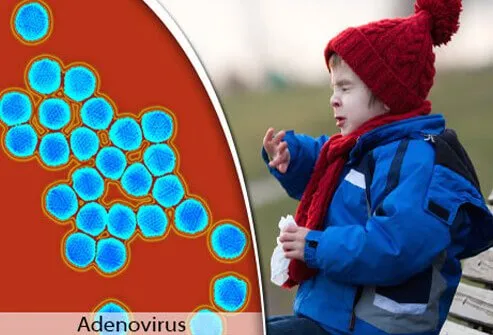
Everyone has had the common cold at some time or another. This extremely common upper respiratory infection is usually caused by one of the 57 types of adenovirus. People infected with the common cold become contagious a few days before symptoms appear and remain contagious until recovery. In total, contagion lasts about two weeks.
As an upper respiratory infection, the common cold causes runny nose, sore throat, and headache. Your lymph nodes may swell. People usually recover within a week with this mild illness. However, it may take up to two weeks to recover.
There is no specific treatment for a cold. Antibiotics are useless against the cold virus and should not be over-used. Over-the-counter pain relievers may relieve body pain. Decongestants can help too. Cough syrups may provide some relief as well. As with all medications, read labels carefully and follow their direction. Be especially careful when treating a child, as many cold medicines are unsuitable for children. Perhaps most importantly, drink lots of fluids. This keeps cold sufferers hydrated and helps prevent another infection from setting in. Adequate rest may also help you recover and feel better.
Nearly 250 different viruses can lead to a cold. Scientists have not yet been able to develop a cold vaccine to protect against all of these viruses.
Coronavirus Infections
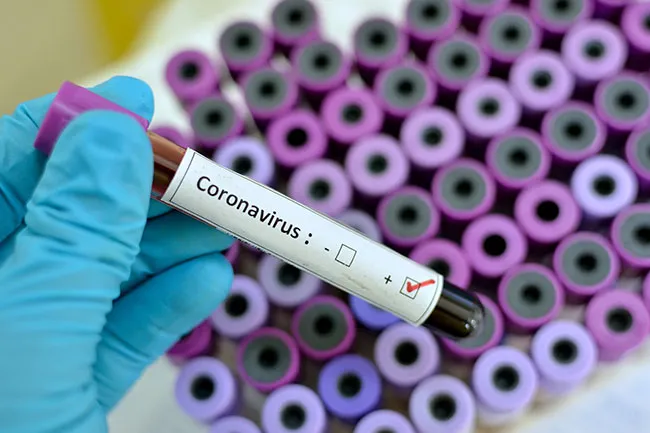
The seven known coronavirus infections that make people sick range from mild to severe, depending on the virus type. This virus family is known to infect various animals, and is also known to mutate easily. Sometimes coronavirus types that infect animals (including bats, civet cats, and camels) mutate to infect humans, and this can have deadly consequences.
A mild-to-moderate coronavirus infection is like the common cold, according to the CDC. Worldwide, people get sick from the four coronavirus types that cause milder infections every day. But three types—the ones that cause SARS, MERS, and COVID-19 (SARS-CoV-2)--have the potential to be fatal, and each of these has led to a significant global outbreak.
Coronavirus COVID-19 (SARS-CoV-2)

The global COVID-19 outbreak was caused by the most contagious strain of deadly coronavirus yet. The World Health Organization declared COVID-19 a pandemic on March 11, 2020. This led to an unprecedented closure of schools, businesses, and public life in the United States and across the world as nations practiced social distancing and mask-wearing to prevent widespread infection, and eventually regimens of vaccines.
COVID-19 is a potentially deadly respiratory infection that originated in Wuhan City, China in December 2019. Once it developed, the virus quickly spread worldwide, setting off a years-long pandemic that infected and killed millions.
Coronavirus COVID-19 Symptoms
As with other lung infections, people with COVID-19 may experience cough and fever, along with shortness of breath. There have been some reports of patients with stomach problems such as diarrhea and vomiting. Others notice a new loss of taste or smell. A low fever, chills, and muscle aches can also be symptoms.
Although many only experience mild/moderate symptoms, others experience more severe symptoms, which may include pneumonia, severe acute respiratory syndrome, kidney failure, and death.
Coronavirus COVID-19 Vaccines and Prevention
Patients with coronavirus COVID-19 have been given treatment to ease their symptoms, also known as supportive care or palliative care. Many infected persons have been hospitalized. This is a problem because many patients need hospital care and outbreaks like this sometimes use up all hospital resources for care. Vaccines and boosters have helped slow the spread of the virus since their introduction in late 2020.
Currently, prevention of the disease, or decreasing risk, is possible by wearing a mask (n-95 or KN-95 for best protection) and maintaining your vaccine immunity with regular boosters. You can also avoid contact with individuals diagnosed with the infection or people who have been in an outbreak area. Also, isolation of infected individuals (quarantine) can help slow or stop the spread of infection. Furthermore, social distancing (keeping about 6 feet away from other people) may be effective in reducing risk. Caregivers should use protection like gloves, gowns and approved masks.
SARS (Severe acute respiratory syndrome)

Severe acute respiratory syndrome (SARS) is a severe viral respiratory infection caused by coronavirus SARS-CoV. The SARS virus outbreak began in China in 2003 and spread worldwide, infecting over 8,000 people before it was contained. SARS virus spreads mainly through person-to-person contact. Since 2004, there have been no known SARS virus cases reported.
SARS may cause fever, chills, muscle pain, shortness of breath, headache, and diarrhea. Most SARS patients go on to develop pneumonia.
SARS Treatment
SARS victims usually require oxygen and possibly mechanical ventilation. Currently there are no medications that aid in SARS treatment. Local, state agencies, the CDC and WHO should be notified immediately if a SARS infection is diagnosed.
SARS Vaccine and Prevention
Chinese and U.S. scientists have been working to create a SARS vaccine, but research has been made difficult by an absence of active disease to test treatments against. Research has been based around monoclonal antibodies, which hold promise as future diagnostic tools for SARS infection and treatment.
Recommended SARS prevention measures include washing hands with soap and hot water or an alcohol-based hand rub, wearing disposable gloves if contacting an infected person's body fluids or feces and throwing those gloves away immediately, wearing a surgical mask, washing personal utensils, towels, bedding and clothes with soap and hot water, and disinfecting any household surfaces that may have come into contact with an infected person's sweat, saliva, mucus, vomit, stool or urine.
MERS (Middle East Respiratory Syndrome)
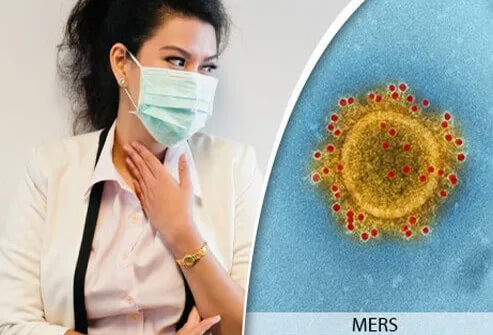
MERS (Middle East respiratory syndrome) is caused by coronavirus MERS-CoV. This viral infection was first reported in Saudi Arabia in 2012, and the original source of the virus is unknown but is suspected to have come from camels. Only two patients have ever tested positive for MERS in the United States. Both worked in health care and had recently been to Saudi Arabia.
MERS can cause a fever above 100.4°F (38°C) with chills or shivering, sore throat, coughing up blood, difficulty breathing, vomiting, abdominal pain, diarrhea, and muscle aches.
MERS Treatment
There is no specific antiviral treatment recommended for MERS-CoV infection. Other forms of medical care may be available to help though. As with SARS, MERS patients usually require oxygen supplementation and possible mechanical ventilation. Local, state agencies, the CDC and WHO should be notified immediately if a MERS-CoV infection is diagnosed.
MERS Vaccination and Prevention
There is currently no vaccine or cure for MERS. The same preventative measures for other respiratory illnesses apply to MERS infection: wash hands or use an alcohol-based sanitizer, cover your nose and mouth when sneezing and throw the tissue away immediately, avoid touching eyes, nose and mouth with unwashed hands, avoid kissing, sharing food or drinks with sick people, and clean and disinfect contaminated surfaces such as doorknobs and bathroom countertops.
Respiratory Illnesses: 13 Types of Lung Infections
This tool does not provide medical advice. See additional information: 
© 1996-2024 WebMD, LLC. All rights reserved.
